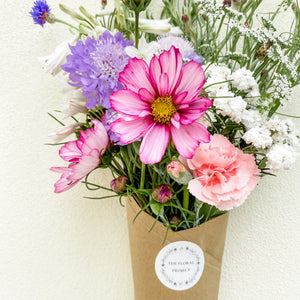Overview
Stocks (Matthiola incana) are richly scented, upright flowers that bring old-fashioned charm and heady fragrance to any cut flower patch. Known for their dense spires of single or double flowers in soft pastel shades, stocks are a wonderful early-summer flower with sturdy stems that make them perfect for cutting. Their perfume is one of the strongest in the garden and their neat form suits both formal and cottage-style arrangements.
What You Need to Know
Botanical Name: Matthiola incana
Type: Hardy annual
Flowering Period: May – July
Height: 60cm
Spacing: 25cm
Sunlight: Full sun
Soil: Well-drained, fertile soil
Pinching: No
Best For: Scented bouquets, early summer flowers, cottage gardens
How to Sow Stocks Seeds
Sowing Indoors (Recommended)
Sow stocks seeds indoors between September and March. Fill trays or modules with peat-free compost and sow seeds on the surface, pressing them in gently without covering, as they need light to germinate. Water carefully and place trays in a bright, cool space at 15-18°C. Germination usually takes 7–14 days.
Once the seedlings have developed two true leaves, prick them out into 9cm pots. Grow them on in a cool, light position. Stocks don’t like being too warm once germinated, so avoid propagators or warm windowsills after emergence.
Harden off young plants by placing them outside during the day for a week before planting out. They can go in the ground from March onwards once the soil is workable, as they tolerate cool spring temperatures well.
Direct Sowing
Stocks can also be direct sown in April or September. Choose a sunny, sheltered site with fertile, well-drained soil. Sow seeds thinly into drills and water well. Once seedlings appear, thin them to 25cm apart.
How to Grow and Care for Stocks
Stocks thrive in full sun and fertile, well-drained soil. They benefit from soil that has been enriched with compost before planting, but they dislike overly wet or heavy soil.
They don’t require pinching and naturally grow into neat, upright plants. Taller varieties may benefit from staking, especially in exposed sites.
Keep plants well watered during dry periods and mulch around the base of plants to conserve moisture and suppress weeds. Avoid overfeeding, as too much nitrogen can reduce flowering and make plants leggy.
Stocks are relatively pest-free, though they can occasionally attract aphids on new growth. These can usually be managed by encouraging ladybirds or using a gentle spray of soapy water.
Tips for Growing Stocks in Pots
Stocks grow well in containers, provided they have enough space and are kept evenly moist. Choose a pot at least 25cm wide and deep, with good drainage. Use a peat-free, fertile compost, and place the pot in full sun.
Water regularly, particularly during dry spells, and feed fortnightly with a balanced liquid fertiliser once the first buds appear. Avoid allowing the compost to dry out completely, as this can lead to poor flowering.
Harvesting & Post-Harvest Care
For cut flowers, harvest stocks just as the lower buds on the stem begin to open. Cut early in the morning or late in the evening for the longest vase life. Place stems into fresh, cool water immediately and strip off any lower leaves.
Stocks have a vase life of around 5–7 days and continue to open from the bottom up once brought indoors. Their strong, sweet scent makes them perfect for scented posies and early summer bouquets.
Stocks don’t need conditioning with heat or special treatments – just fresh water and a cool place to rest before arranging.
Troubleshooting & Common Issues
No Germination: Stocks need light to germinate, so ensure seeds aren’t buried. Keep compost moist but not waterlogged.
Weak or Leggy Growth: This often happens when seedlings are kept too warm. Move them to a cooler, brighter spot once they’ve germinated.
Yellowing Leaves: Can indicate overwatering or poor drainage. Ensure soil or compost is free-draining and avoid waterlogging.
Few Flowers: Overfeeding can result in lots of leafy growth and few flowers. Use a balanced fertiliser and don’t overdo it.
Tips for Floral Arrangements
Stocks are a classic flower for early summer bouquets, adding both scent and structure. Their tall spires make them perfect for the centre of arrangements, while their muted colours blend well with other early-season flowers.
Pair stocks with cornflowers, sweet peas, or orlaya for a romantic, cottage-style feel. Their scent makes them a favourite for bedside or kitchen table arrangements where they can be fully appreciated.
Double-flowered varieties have a fuller, showier appearance, while single forms often attract more pollinators and offer a wilder, more natural look.
Final Thoughts
Stocks are a joy to grow, bringing early fragrance and elegant colour to the flower patch. Easy to raise from seed, tolerant of cool conditions, and perfect for cutting, they are a must for any flower grower who values scent and structure. Grow them in pots or borders, cut them for the vase, and enjoy their perfume all through the early summer months.









